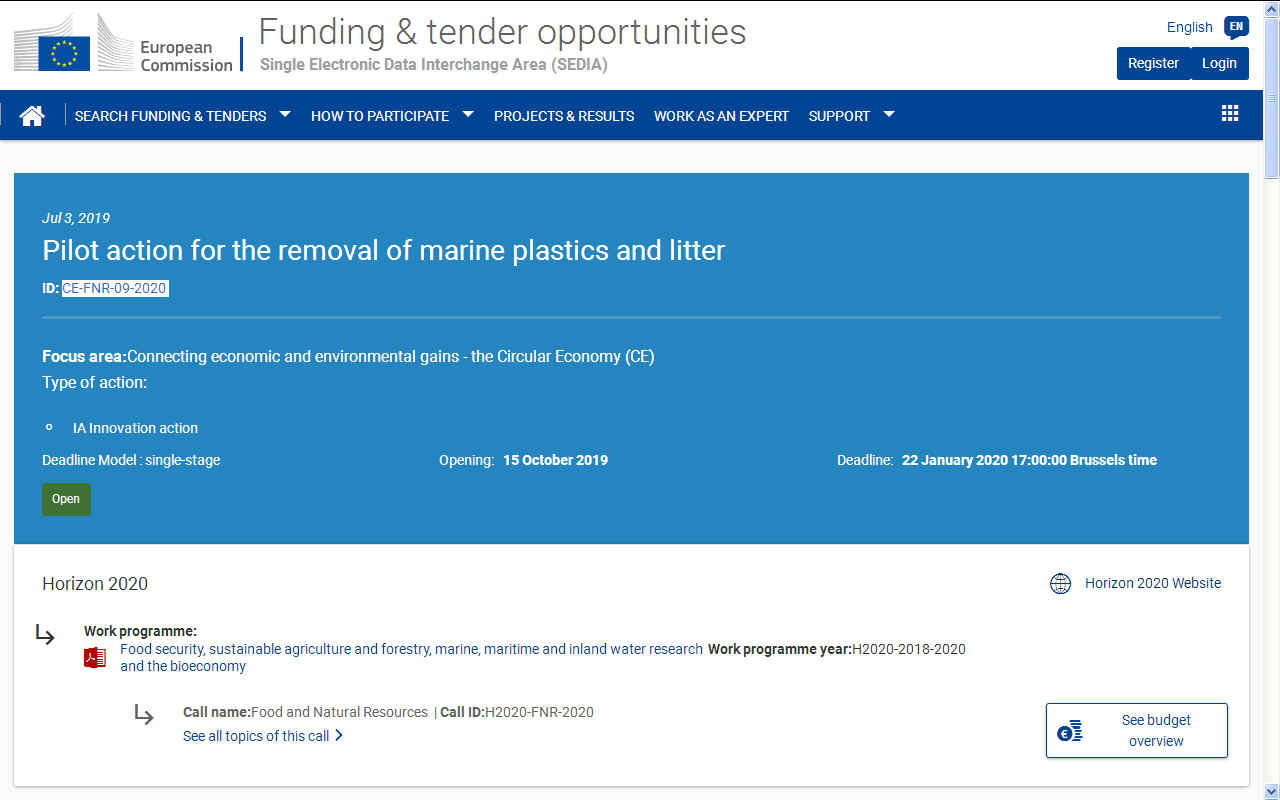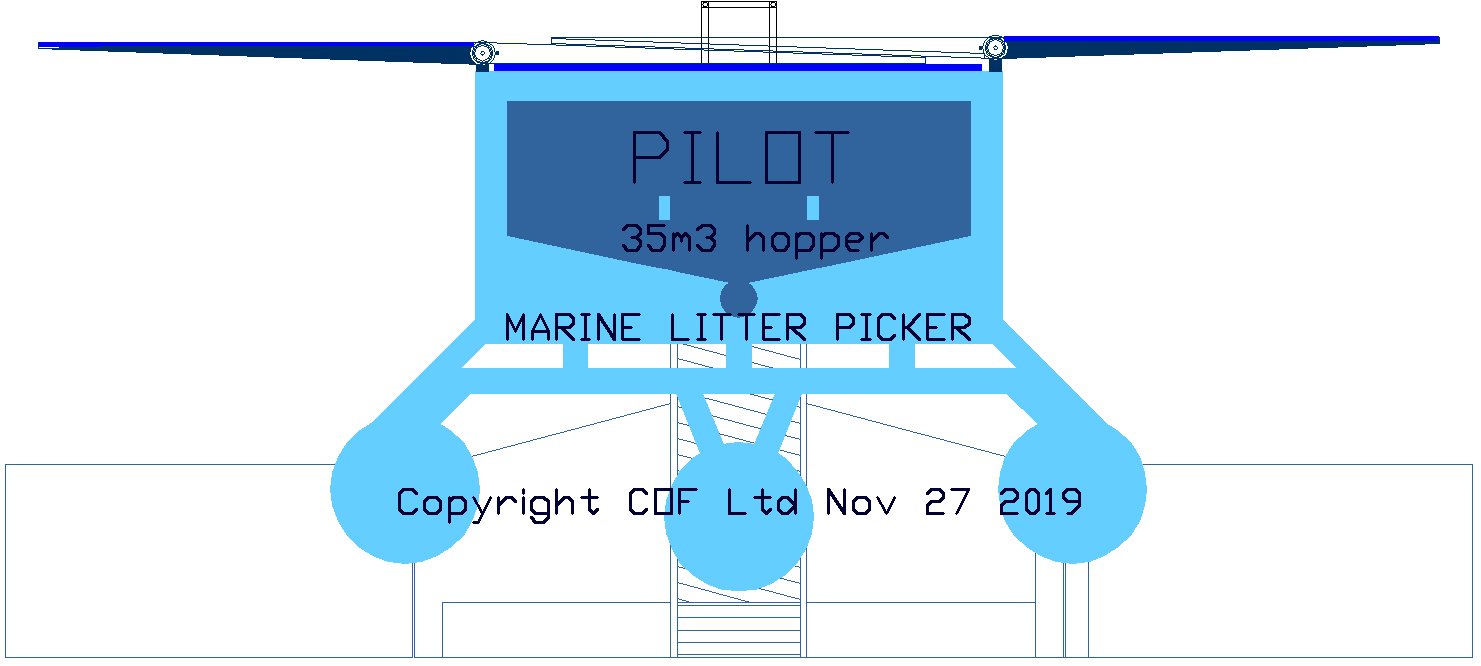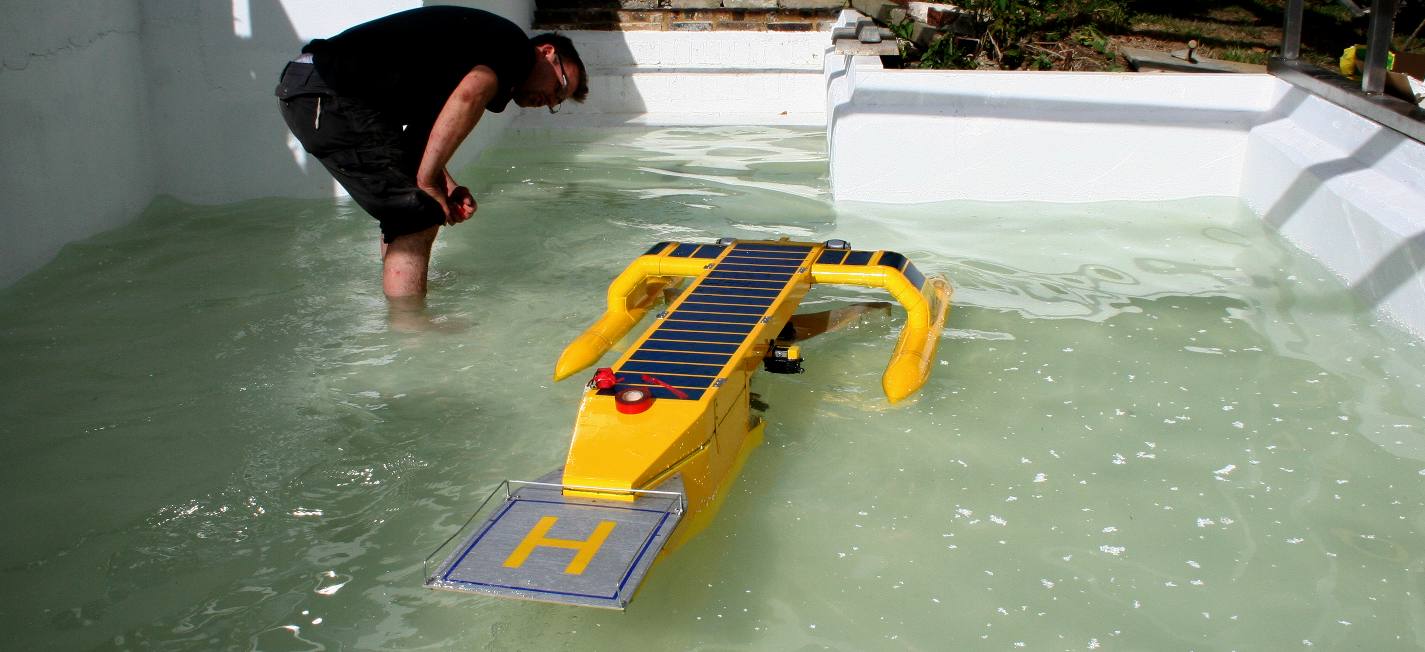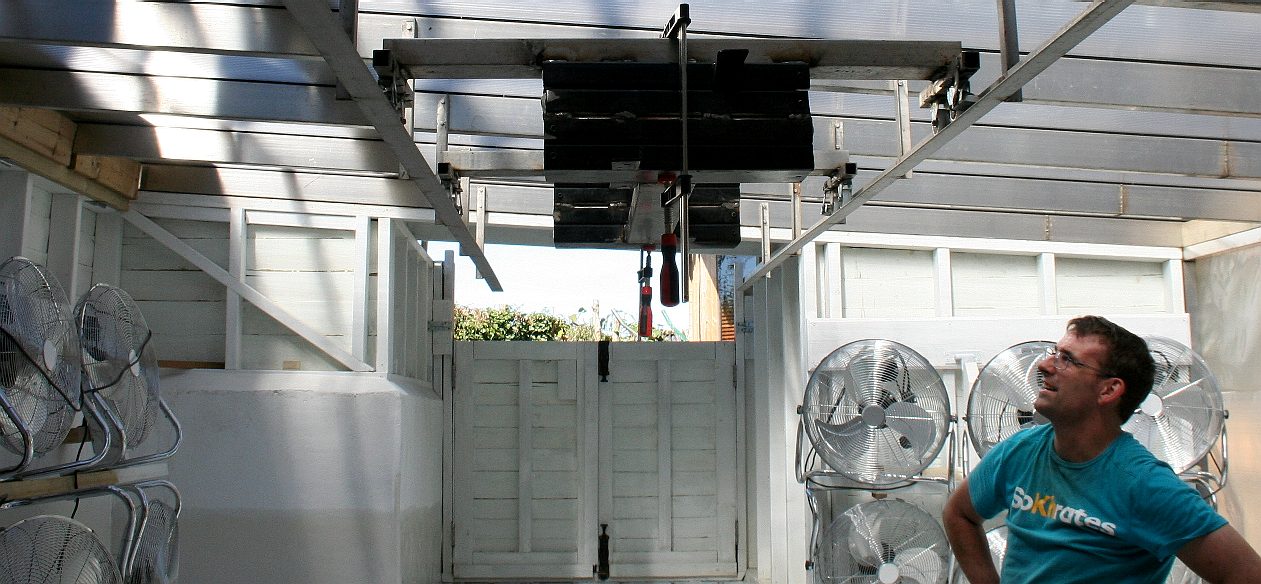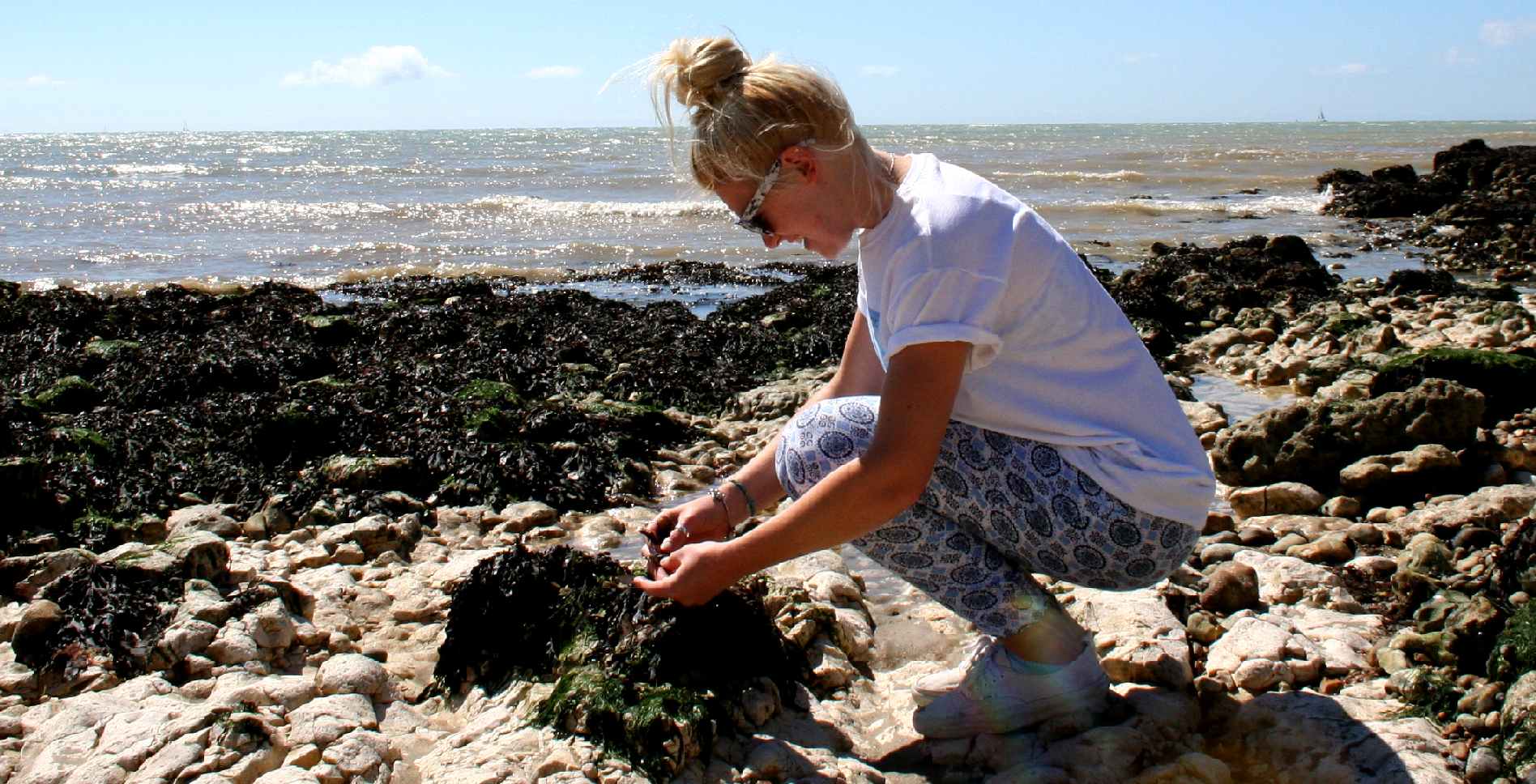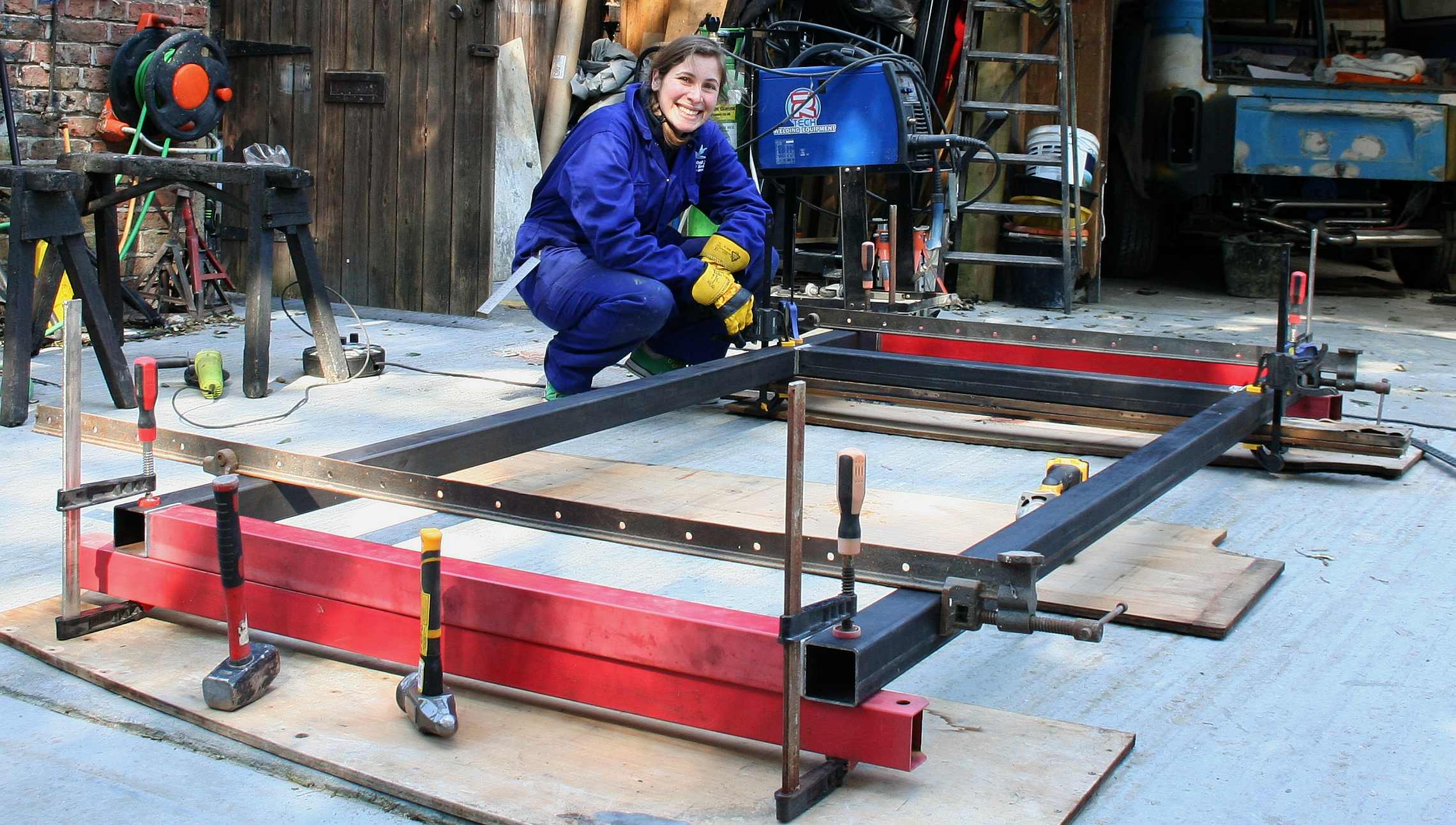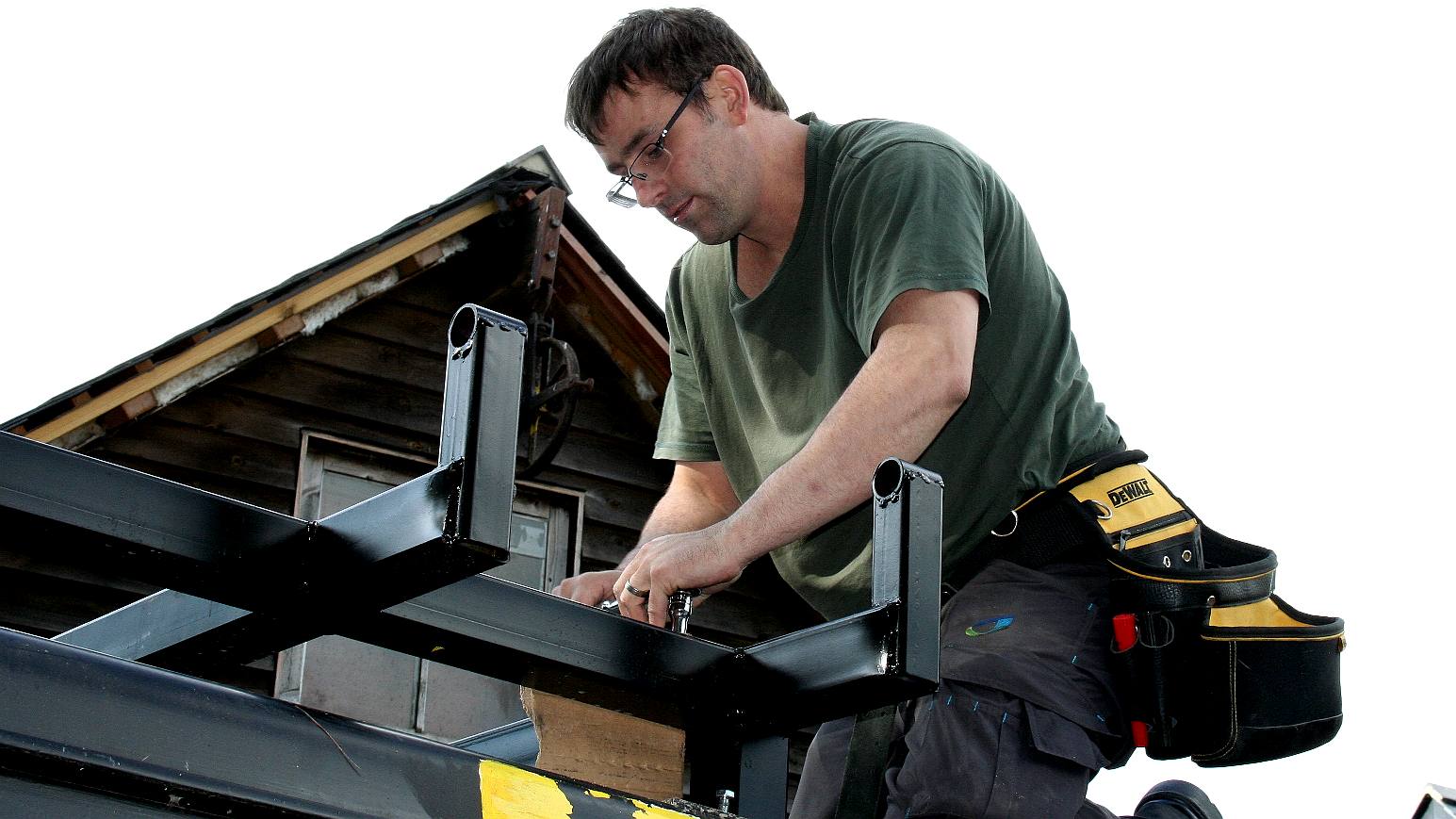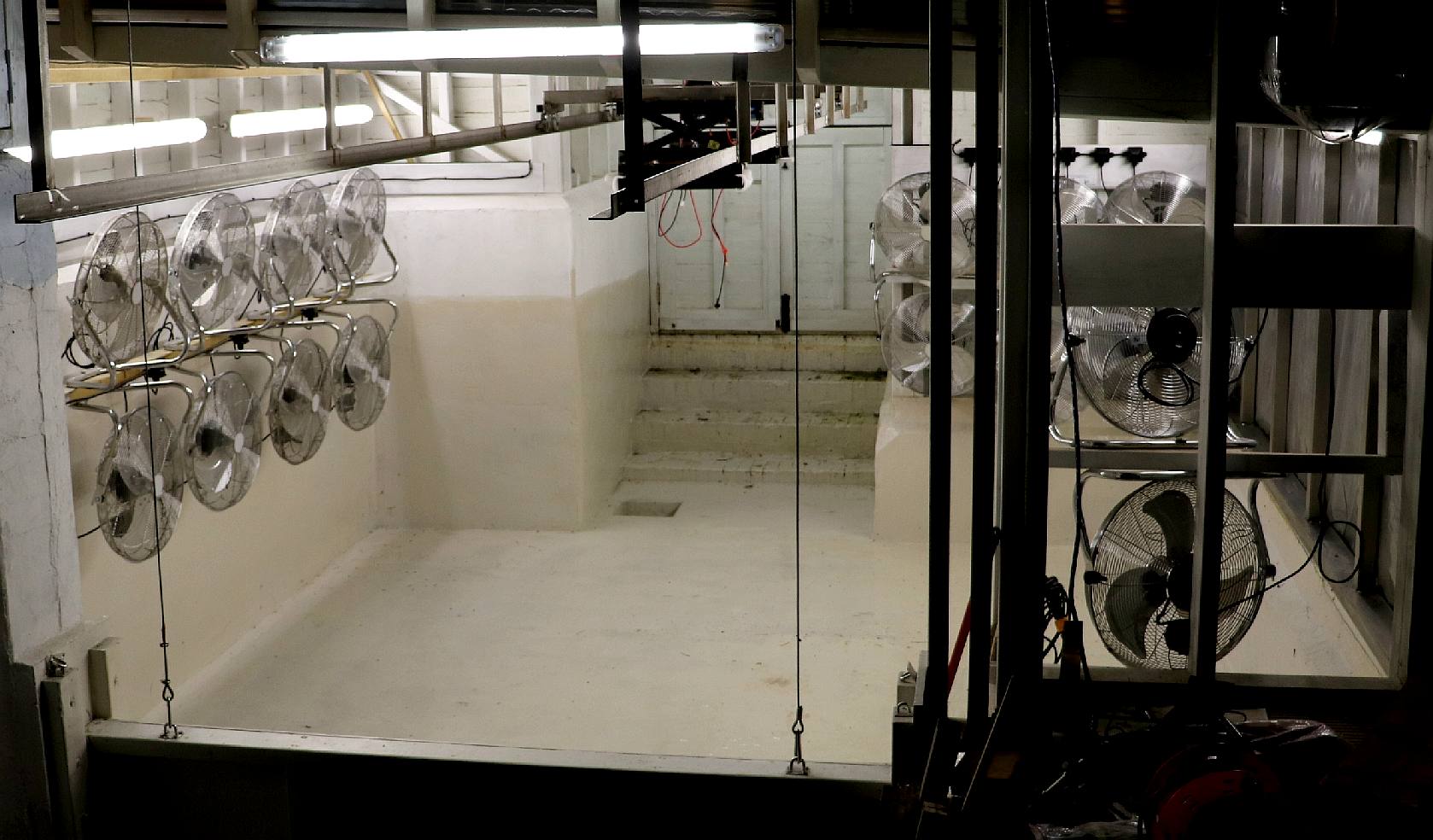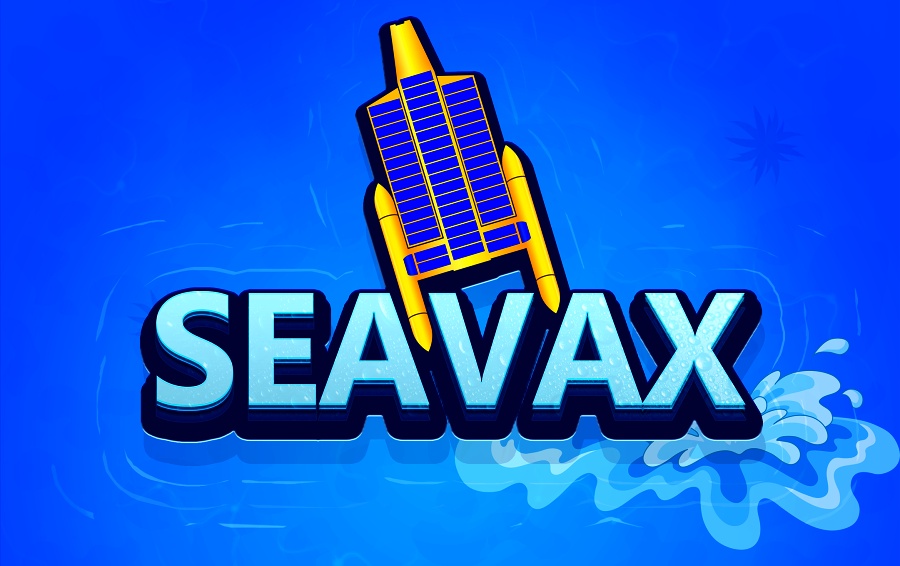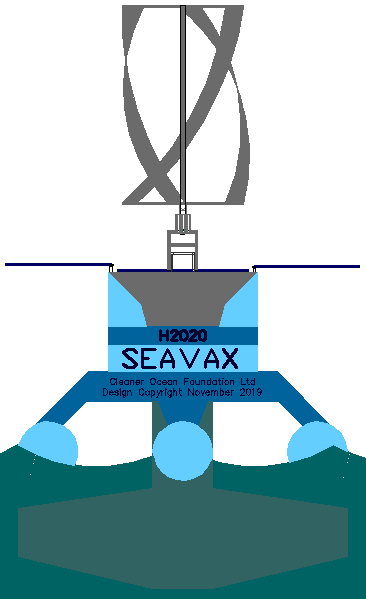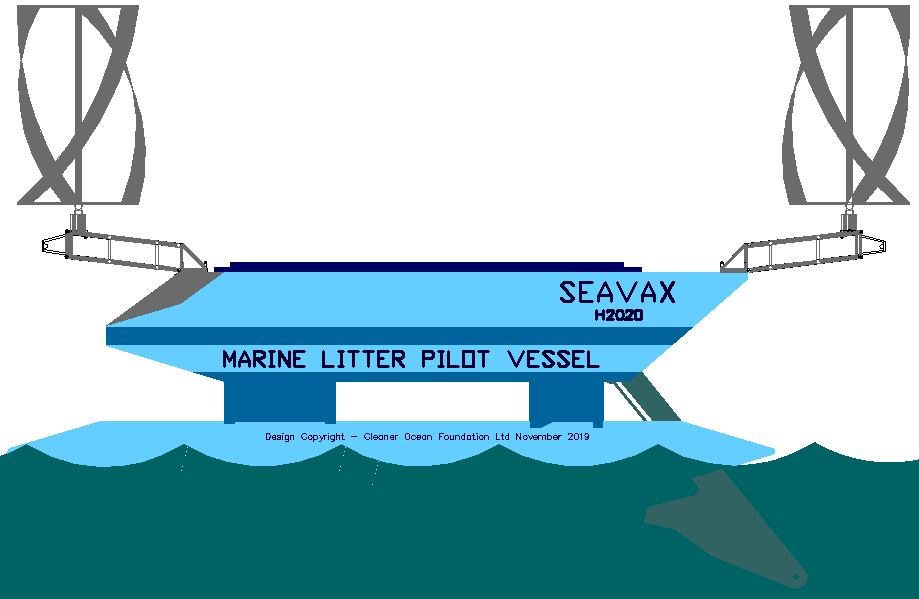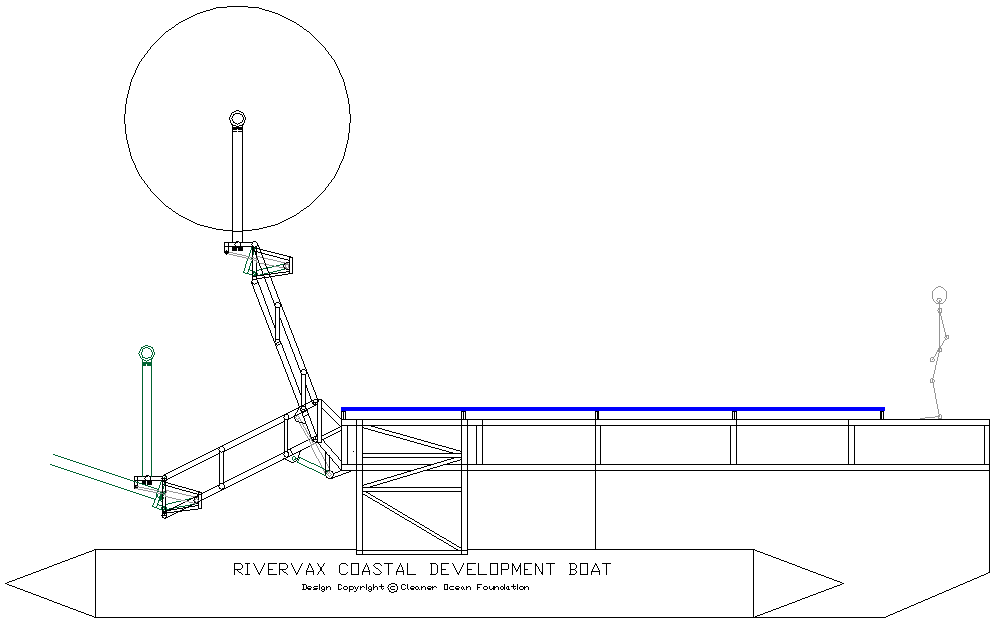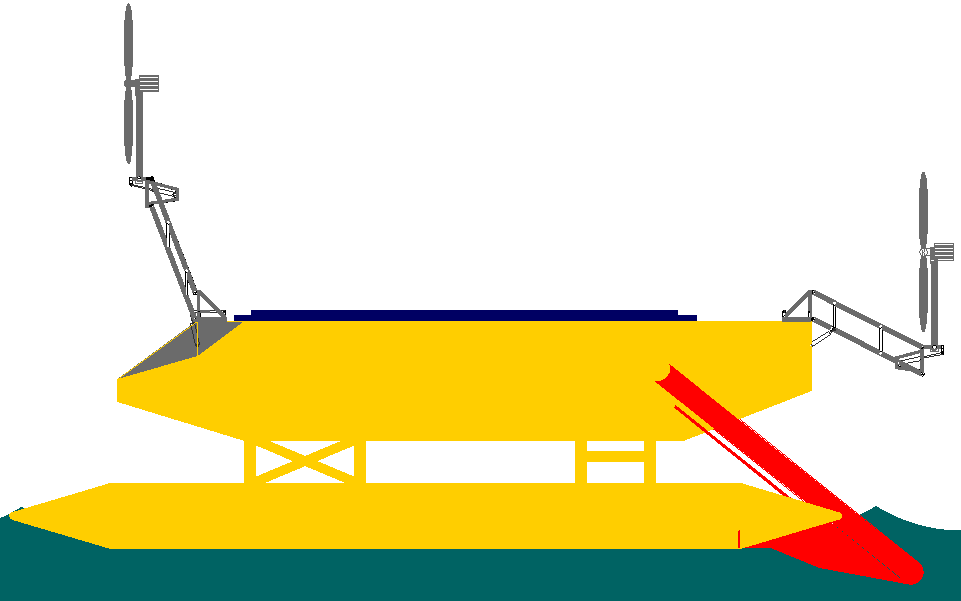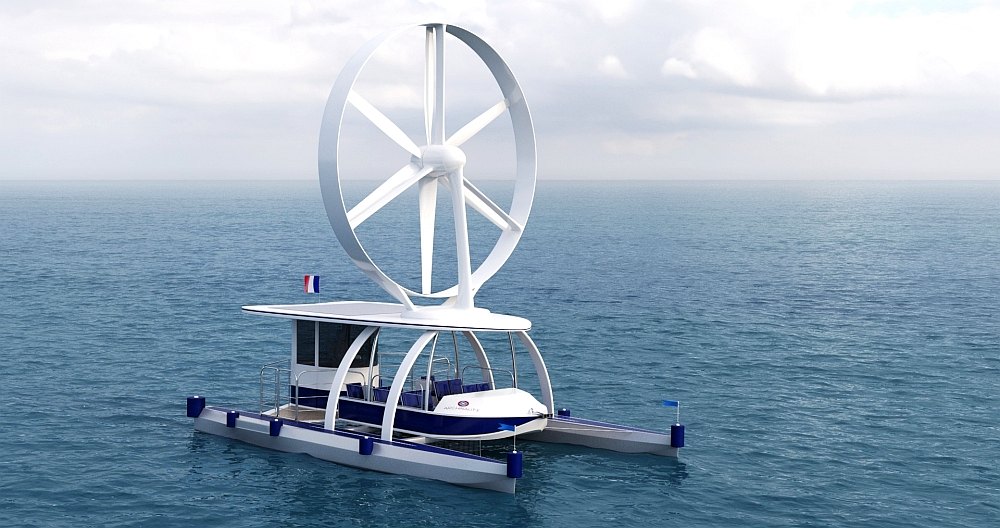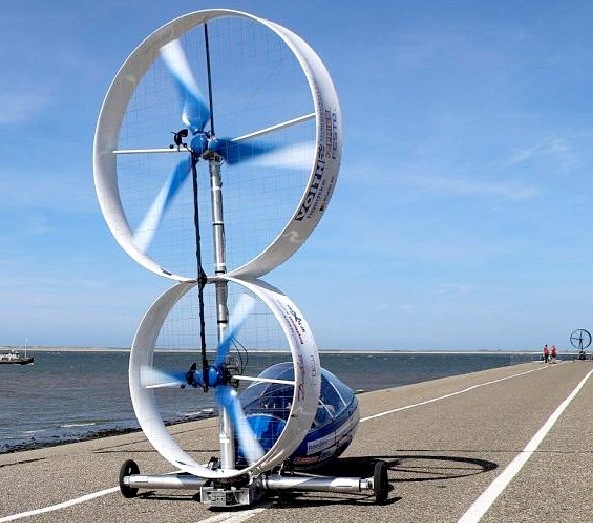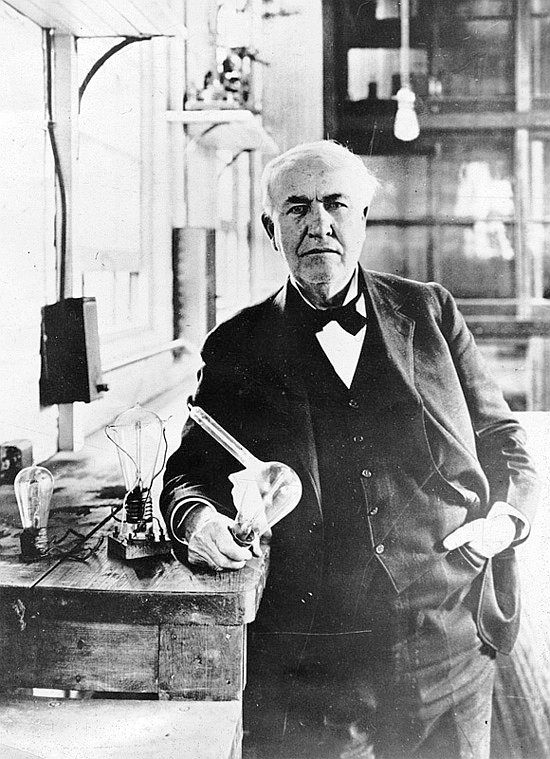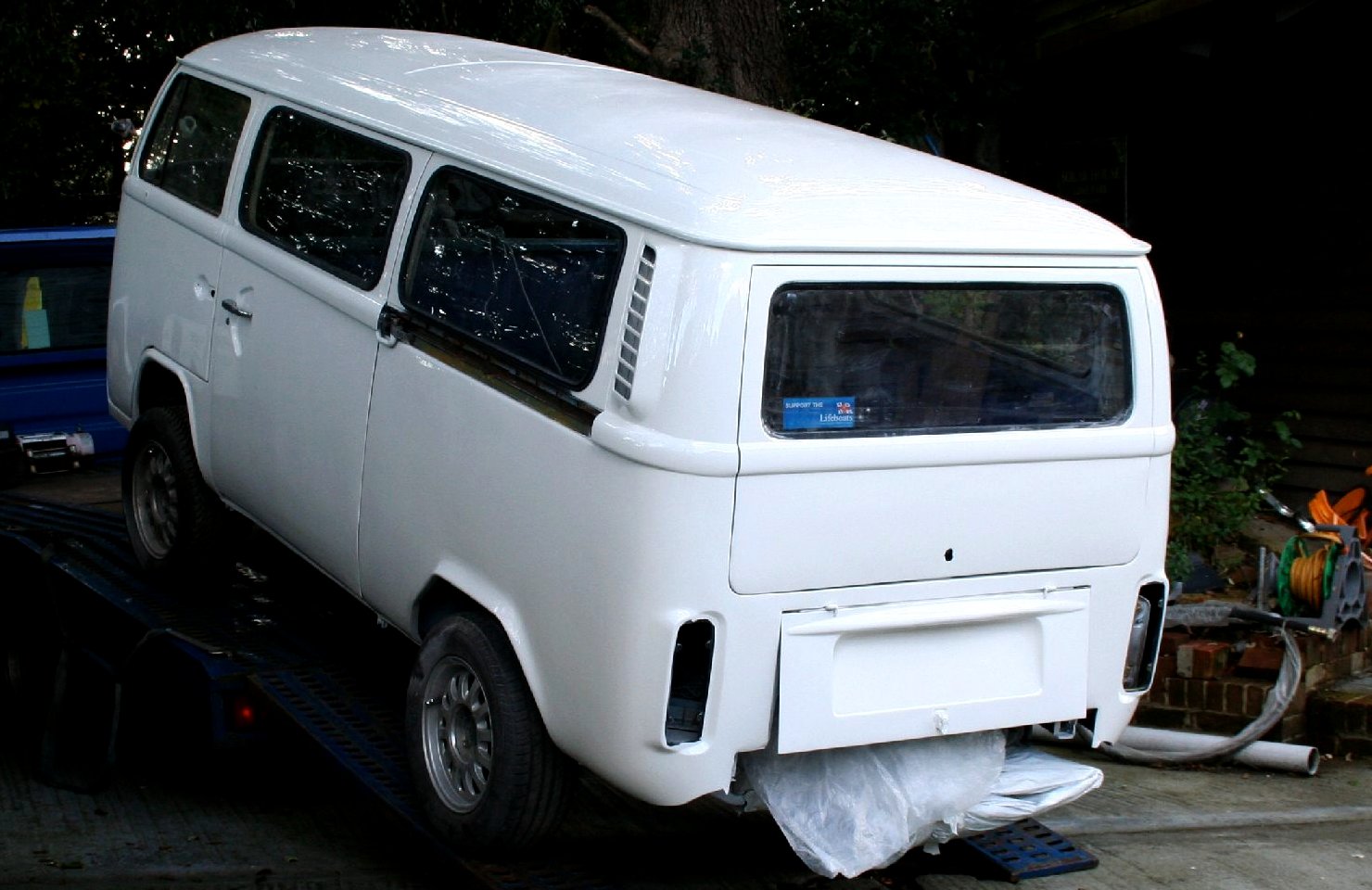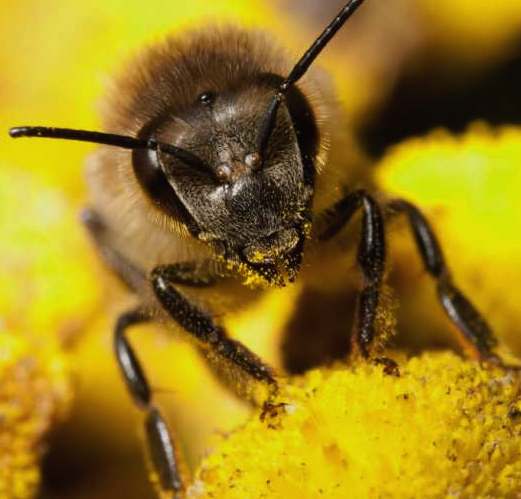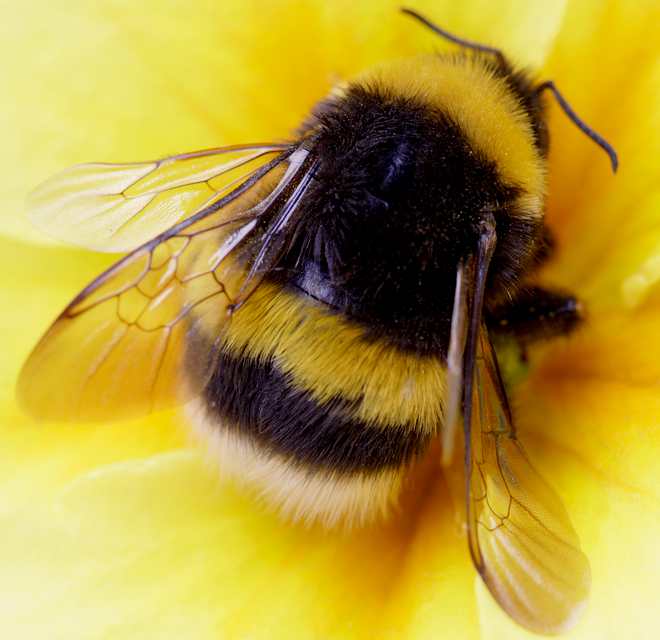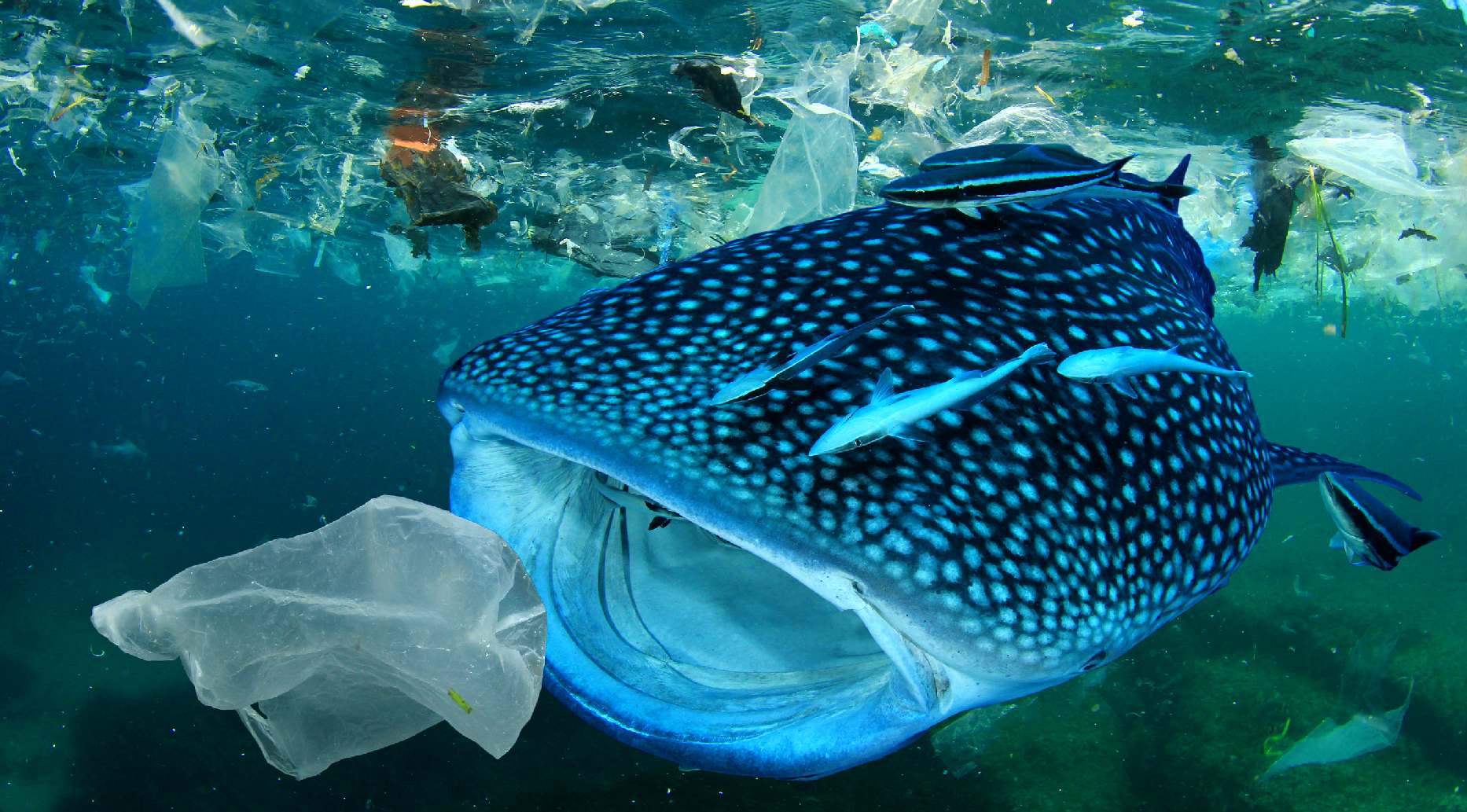|
SEA & RIVER VAX proven concept - overview - cradle to grave
Please use our A-Z INDEX to navigate this site, where page links may lead to other sites
|
|||||
|
Combined plastic discharge coupling and survey drone landing pad. |
|
50 - 150 m2 holding tank for collected ocean or river waste depending on drift or tethered harvesting operations.
|
|||
|
|
|
5083 alloy hull for corrosion free service life. Specifications. |
|||
|
|
|
||||
|
Large 220 m2 + area of photovoltaic panels as arrays that track the sun autonomously. |
Up to 40kW wind turbines adjustably boom mounted front and rear to track wind autonomously (not as shown in picture at the front). |
||||
|
|
|
||||
|
Trimaran hull configuration for stability at sea. |
Modular construction to simplify production (and to allow easy adaptation). |
||||
|
Large (patent ) 2-stage 13.5 meter filter-collector head to vacuum up plastic particles - with adjustable operating height and safety features to protect marine life - and lift out ability during emptying or relocation transits to reduce hull drag.
The
SeaVax (proof of concept model) is now a permanent exhibit at Herstmonceux Museum in
Sussex. Where a whole unit has been devoted to ocean plastic, as testimony to man's senselessness.
|
|||||
|
OCTOBER 2019 - The European Commission announced a call for proposals for the removal of marine plastics and litter in October 2019, with a submission deadline of 22 January 2020, now passed. The Cleaner Ocean Foundation is a member of a consortium that lodged application under this call. The Foundation is interested in working with development partners on other calls where mass selective water filtration is asked for. Click on the above picture for details of the Pilot action call in 2019. Click here to read an outline of the application we were supporting with a Dream Team, basically to build a smaller version of SeaVax as a prototype. This project is now on ice as of May 2020, where H2020 funding was unsuccessful. The Foundation is preparing to launch a zero carbon yacht project to beat the Atlantic solar record, starting in April 2021. The energy harvesting and COLREGs compliant navigation platforms are essentially the same as for the Elizabeth Swann.
"Marine litter is high on the scientific and political agendas and of major concern internationally. More than 80 percent of marine litter is plastic. It is estimated that by 2050, more plastic could be in the ocean than fish. It can be found on beaches (mostly produced locally), on the ocean surface, in animals and on the seafloor. Microplastics can get into the food chain, together with the integrated and adsorbed toxins. It is estimated that each year 5 to 13 million tonnes of plastics reach the seas and oceans (worldwide), becoming eventually the main source of microplastics. In addition to possible health risks, the damage to marine ecosystems and the blue economy (tourism and other maritime sectors) due to plastic litter are enormous.
For this reason, urgent action is needed both for the prevention and for the removal of existing marine litter, notably plastics and microplastics."
SEAVAX TIMELINE
2015 - SeaVax started life as a project by Bluebird Marine Systems with the build of a 1/20th scale proof of concept model (POC) that was exhibited at Innovate UK on the 9th and 10th November. The idea was to create a vessel that could clean vast areas of open water using only solar and wind energy, to avoid adding to global warming. It was seen as a tool to recycle a valuable resource that is presently being wasted and is damaging marine ecology - with some 700 species encountering micro plastics, many coming to harm.
According to the United Nations, plastic pollution is conservatively estimated to have a yearly financial damage of 13 billion USD. The costs stem from the plastic’s impact on marine life, tourism, fisheries and businesses.
OCEAN CLEANING MACHINES - This is what SeaVax looked like in 2016. The draft specification is for a vessel capable of filtering seawater using only energy from nature, so not adding to climate change and acid oceans. The vessel needs to be of a size to cope with 8 million tons of plastic entering the sea every year, operating in numerically containable fleets to transport recovered plastic to land for recycling. In 2021, IBM hope to cross the Atlantic autonomously in a trimaran called Mayflower 400, using an AI Captain. If they succeed, they will have proven that SeaVax could operate as anticipated.
2016 - Bluebird Marine Systems (BMS) built a robot lab and a water test tank, then conducted model trials in water where micro and macro size floating plastic put in the tank was recovered by the POC model quite effectively proving the filtration concept. BMS conceived a low cost portable boatyard that doubled as an amphibious beach launching system to reduce production costs. This phase of development was supported by crowdfunding via Avaaz. BMS suffered a significant net loss during this time and could not keep operating as it was.
BEACH LAUNCHING/SERVICING MACHINES - The Amphimax was proved as a concept in late 2021, waiting for publication as student volunteer time allows. The proof of concept rig successfully carried the SeaVax (forward, reverse and steerable) for the first time in trials between October and December 2021
2017 - The Cleaner Ocean Foundation took over SeaVax to keep the project alive, further developing the SeaVax portable boatyard theme (launcher) called AmphiMax in 1/20th scale to demonstrate low cost production possibilities. The advantage of this machine is the ability to launch and recover machines from outside territorial waters - so avoiding possible certification and insurance issues. Estimated cost per unit in steel around £250k. Vessels could have been registered in robot gracious countries.
An application for Horizon 2020 funding in 2017 was not ranked high enough in the pecking order putting the project back a year. Three trademarks were secured at no cost to the Foundation. The rebuild of a VW tour bus for ocean awareness events continued at a slower pace (an ongoing project) for future promotions.
2018 - Through 2018 workshop facilities were improved by volunteers to include lining a leaking underground water tank with GRP to empty the water basin into, fitting fans to be able simulate storm conditions and adding a gantry loading system for the water test tank.
Seawater filtration was advanced with help from a postgraduate marine biologist from the National Oceanography Center, Southampton. A 10 Year Plan was published and lobbying of the G20, United Nations and other international organizations began, attracting encouraging replies, but no offers of financial support.
2019 - In this year Patent rights relating to energy autonomous vessels were donated at no cost to the Foundation. A smartphone ocean awareness game is nearing launch and a quarter scale test rig is being developed to prove the wind and solar energy harvesting theory of the SeaVax concept at quarter scale, with input from a masters degree student from Université de Liège, Gembloux Agro-Bio Tech. A patent application is being drafted in relation to ocean cleaning and filtration based on unpublished research. Again, at no cost to the Foundation. Ocean literacy is also important to make the public aware of plastic waste, such as the free SeaVax game and VW Tour Bus being painted. Compared to Boyan Slat's Ocean Cleanup Project, SeaVax has cost around $650k to develop compared to a reported $31m for the boom system, but then the boom project is far more advanced, being already out in the ocean undergoing development. As with the boom system, any ocean cleaning vessels are sure to be subject to design and conceptual improvements as we learn more.
Many think, and you may agree, that somewhat perversely, the Charity Commission (UK) decided the SeaVax project was not charitable, putting another (financial) nail in the coffin of this social enterprise. (February 2019)
2020 - Here we are in 2020, for another year full of potential. We were part of two separate bids for EU funding, in January and February. Unless you have coordinated a H2020 consortium, you will not know how much work that is. We would have attended Oceanology International in London in March, but for COVID19. It remains to be seen if the European Maritime Day in Cork, Ireland in May and Seawork in Southampton in June, are still on the cards with lockdown hampering progress. The fans in the test tank were wired and the water-resistant LED lighting installed in March. We also attend other events and will be following COP26, that was to be hosted in Glasgow, Scotland in November 2020, but is now set for November 1-12 2021.
2021 - Two European Commission funding applications having been unsuccessful, SeaVax was effectively put on ice from May 2020. Some elements of the concept will be developed as part of a solar powered yacht called the Elizabeth Swann. But not the selective filtration and recycling head that deals with micro plastic and fibres and large plastic objects, including ghost fishing nets. This is a real shame. We imagine that the Commission has something better on the cards. We hope that whatever it is it will help to prevent sterilization in humans and marine mammals from toxin bio-accumulation, and cancer from eating infected seafood. We hope that the rules for Horizon Europe will encourage innovators looking at these problems.
We did our best - and will remain available for consultation, for any team of marine engineers/scientists willing to take on the challenge.
WHAT ELSE ?
Funding dependent in 2020, the plan was to float a budget 11-12 meter coastal test rig, building on what has been learned from 2015 to 2019. The term 'coastal' includes river and offshore workboat. Funding is as always, the main obstacle to progress. The EU, G20 and UN will not pay for ocean cleaning, but are keen to help the development of suitable technology, even where such funding may not hit the mark due to inhibiting policies and rules - we appreciate the effort.
Against that tide of inflexible attitudes the project was eventually cancelled. Though free licenses are still available, subject to payback of losses sustained and developments not paid for.
The Foundation is hopeful that there may be other ways of cleaning rivers of microfibers upstream. See Fionn Ferreira's emulsion extraction experiment as one example with some potential. There are of course others.
SeaVax would work well to cover aspects of marine cleansing that The Ocean Cleanup Project might not cover with their proposed fleet of drift-booms and river skimmers.
While waiting for political and policy changes of heart in relation to funding, the Foundation is now concentrating on hydrogen as a fuel for ocean transport; zero carbon. See the Jules Verne Hydrogen Challenge, aiming for the 150th anniversary of the French author's prediction.
2022 SEAVAX SARGASSUM
A modified SeaVax, to deal with the sargassum crisis, present affecting the Gulf of Mexico and Caribbean Islands. In need of a study, proof of concept, and serious funding support.
2023 SEANET SARGASSUM SOLUTIONS
Setting the standard, using SeaVax as a baseline example. Hoping to attract like minded ocean entrepreneurs. Bulk ocean sargassum harvesting machines will need Artificially Intelligent fleet control software to handle the logistics of seaweed collecting operations at this scale: 24 million tons per year (and rising).
SeaNet would also coordinate AmphiMax operations, for more efficient offloading at dedicated beach locations, where there is not other option/
OPEC - OIL/PLASTICS CIRCULAR ECONOMY
Many see plastic packaging as a menace that has no virtues - and at first sight we would have agreed that as it stands - plastic for packaging is crazy where there is no safety net.
Whereas, if a system can be developed to effectively recycle plastic on land, in tandem with recovery and recycling from the oceans - then we will have created a plastic cycle that is circular in concept and sustainable. The carbon footprint for plastic is lower in many cases than other packaging mediums. We have a duty to explore the possibilities given the harm we are causing to nature with packaging and climate change. We need climate and ocean friendly packaging.
G7, G20 and other events such as EU Maritime Days, have so far failed to address this environmental challenge.
PILOT H2020 LITTER VESSEL - A proposal for a 17 meter machine capable of working close inshore and offshore, using large vertical axis wind generators of an advanced design (not as shown here) allied to a respectable solar panel area, to collect marine plastic for transfer to land for recycling. Such machines might thus operate in northern latitudes where sunshine is reduced - and don't forget that the sun does not shine at night. Wind turbines also provide useful navigation thrust to supplement solar power. Land yachts featuring wind turbines regularly sail downwind faster than apparent windspeed and directly into the wind. While SeaVax may not aspire to such feats, transits along trade routes will be quicker with turbines raised. See the Archinaute below, a wind turbine powered concept from Charles-Henri Viel under development in 2019.
12m RIVER SAMPLER - This is a proposal for a low-budget river or inshore development vessel with reduced energy harvesting capacity and endurance.
Funding being the main blocker to development, lobbying is seen as vital to further research as a more dedicated drive toward support for ocean cleaning projects - not just SeaVax - we include any and all promising ocean cleaning projects like the samples listed below. Crowdfunding could help with costs not supported by grants, such as lobbying administration. Corporate sponsorship from like minded concerns is also a possibility for ocean awareness campaigns. At this time volunteers support the project with generous help and free facilities.
A zero carbon ferry proposal holds the potential for easy conversion to a RiverVax. In the same way a multi-purpose design like that shown below could be adapted to become a zero emissions fishing boat.
MULTI PURPOSE MACHINES - A proposal for a small coastal cruiser or (Cross Channel) ferry designed in draft form, could easily be adapted to either a zero carbon fishing vessel or a plastic cleaning machine.
ARCHINAUTE - In 2019 Charles-Henri Viel began build of a wind turbine powered catamaran that generates electricity for storage in batteries to overcome lulls in energy harvesting. There are scant details of the drive system, but this is a development of the rotary sail concept of Peter Worsley, brought into the modern age of electricity. The concept is not a million miles from SeaVax, except for the missing solar panels and the fact that this is not a workboat. Although, the innovator has proposed use as a fishing boat.
ROTARY SAILS - Wind turbines seem to work just as well on land as on the sea as sails to propel vehicles. Inventor, Peter Worsley patented the forerunner of these systems in 1998. The Baltic Thunder in the picture above came second in a land yacht drag race in 2019 in the Netherlands. The proposed Pilot SeaVax uses two turbines, one at either end of the vessel, each adjustable for height.
PERSISTENT DEVELOPMENT - Thomas Edison began serious research into developing a practical incandescent lamp in 1878. He filed his first patent application for "Improvement In Electric Lights" on 14 October 1878. After many experiments, first with carbon in the early 1880s and then with platinum and other metals, in the end Edison returned to a carbon filament. The first successful test was on 22 October 1879, and lasted 13.5 hours. He was not the first to think on the making of a practical light bulb, but he is an inspiration as to building a system whereby they might be economic to use in place of candles and gas lamps, in the process working with others and overcoming legal obstacles. Finally, tungsten filaments and quartz halogen bulbs appeared - all to be ousted by light emitting diodes - some 100 years later. It is all too easy for naysayers to pull apart a concept, it requires vision and devotion to plug gaps in knowledge and perfect what appears impossible to achieve by onlookers.
OCEAN CLEANUP PROJECTS A - Z
* Adidas * Algalita research foundation * Aliance to end Plastic Waste * Boyan Slat's ocean booms * CLAIM H2020 EU marine plastic project * 4Ocean recycled plastic bracelets * Earth Day ocean plastic fact sheet * Fionn Ferreira's ferrofluid extraction of microplastics * FlashLight Press - Michelle Lord, Julia Blattman: The Mess That We Made * Junk Raft - plastic expedition * Plastic Oceans Canada * Plastic Oceans Org * Seabin * SeaVax autonomous drones * Surrey University PIRATE & Triton
POSSIBLE SWITCH FROM 'SOCIAL ENTERPRISE' TO 'COMMERCIAL VENTURE'
The development log-jam stems from the fact that nobody is willing to accept responsibility for recovering plastic in international or in territorial waters. Hence, there is no customer - and without a customer - there is nobody to charge, hence no business.
Beach cleaners do not charge for sweeping beaches, they are funded by charitable donations and volunteers. Councils do not pay them for cleaning the beaches, but they do pay (and charge householders and businesses) for sweeping the streets and emptying bins. Yet (in the UK) the shore belongs to the Crown, and there is a 10 mile territorial coast.
Logically then, the Crown should either pay contractors to sweep plastic from their waters, or provide that service themselves. In India and the USA, the Government (municipalities) are paying for river cleaning.
In the UK there is a £0.05p tax on plastic bags that could be paid to beach cleaners to offset their costs. For example, the Waitrose supermarket chain in the UK supports the Marine Conservation Society from the bag tax.
If it were that nations bordering shorelines were to agree to pay for landed plastic collected in their geographical region, we might pass the SeaVax project to any waste recycling business willing to carry forward the torch, when they might devise a Business Plan and attract investors.
Until then we have a stalemate situation, with marine life suffering as a result of indecision.
The Foundation will write open letters to the G20 and the United Nations this year to confirm acceptance or refusal of responsibility for plastic emanating from their rivers and shores.
THE BUMBLEBEE CAN FLY
"According
to recognized aerotechnical
tests, the bumblebee
cannot fly because of the shape and weight of his body in relation to the
total wing area. BUT, the bumblebee doesn't know this,
This curious scientific anecdote underscores the approach of Cleaner Ocean Foundation engineers when facing a challenge; we become bumblebees. We first of all believe a task can be done and just look for how to do it. Because, if you believe something cannot be done, then you will never find a solution, because you cannot conceive that there is one, making it pointless to look. We are reminded of this story because we colonies of bumble bees around our premises. They do not bother us and we enjoy watching them defy the laws of physics. Call it inspiration if you will.
BUMBLEBEES CAN'T FLY - Magnan refers to his assistant André Sainte-Laguë. Some credit physicist Ludwig Prandtl (1875–1953) of the University of Göttingen in Germany with popularizing the idea. Others say Swiss gas dynamicist Jacob Ackeret (1898–1981) did the calculations. Howsoever it came about, it is plain that you should not entrust the creative spark to theoreticians. They'll scupper you before you begin with a barrage of negatives. Worse still, these scientific glory seekers will put off investors, who, tend to believe these highly qualified party poopers - because investment depends on qualified support. For this reason we would rather show than tell. We'll let the theoreticians tell you we've achieved (or are trying to achieve) the impossible - and maybe generate another amusing scientific anecdote for future generations.
The earliest reference to the above quote is in a 1934 book: "Le Vol des Insectes" by French entomologist Antoine Magnan (1881–1938). The following passage appears in the introduction:
"Tout d'abord poussé par ce qui se fait en aviation, j'ai appliqué aux insectes les lois de la résistance de l'air, et je suis arrivé avec M. Sainte-Laguë à cette conclusion que leur vol est impossible."
This translates to:
"First prompted by what is done in aviation, I applied the laws of air resistance to insects, and I arrived, with Mr. Sainte-Laguë, at this conclusion that their flight is impossible."
LINKS & REFERENCE
http://gpsworld.com/rio-olympics-clean-up-bay-with-gps-helicopters/ http://cleanearthfuture.com/seavax-robotic-vacuum-ship/
WHAT DRIVES US - It is pictures like this whale shark swimming in garbage that it is about to ingest that makes our blood boil. What are we doing, letting a situation like this develop? The fish eat the plastic and we eat the toxic fish. We are slowly poisoning ourselves and our world.
|
|||||
|
AMUSING OR SAD? - Incredible how some people blog before thinking. We wonder where they imagine development money comes from to design and test something as innovative as an ocean cleaning machine on this scale, or how one raises a profile in order to attract investment for research.
The project was not commercial or profit motivated and lost money consecutively over three years, despite volunteers working for nothing and crowd funder generosity. Some writers appear not to understand renewables and what is possible to harvest from nature. They also fail to comprehend how much harm they can do from unthinking remarks, just for a cheap thrill from seeing their comments in print, potentially libelous at that!
All progress depends on research from those who are brave enough to give it a go and determined enough to go from the drawing board to cut metal for experimentation. That is the hard part.
Any fool can spout an uninformed opinion without breaking a sweat. As a matter of fact, the SeaVax proof of concept model did scoop plastic during a test-tank simulation with ample power derived from nature. Sufficient money was not raised to scale up and do the same at sea (as of Jan 2021) to please the minority naysayer. As the pollution problem worsens, it might be that something has to be done. What has any naysayer done about the 5 plastic gyres?
"Be the solution, not the pollution."
ABS - BIOMAGNIFICATION - CANCER - CARRIER BAGS - COTTON BUDS - DDT - FISHING NETS - HEAVY METALS - MARINE LITTER - MICROBEADS MICRO PLASTICS - NYLON - OCEAN GYRES - OCEAN WASTE - PACKAGING - PCBS - PET - PETROLEUM - PLASTIC - PLASTICS - POLYCARBONATE POLYOLEFINS - POLYPROPYLENE - POLYSTYRENE - POLYTHENE - POPS - PVC - SHOES - SINGLE USE - SOUP - STRAWS - WATER
BIOMASS - BUILDING MATERIALS - CANCER - CLOTHING & SHOES - CO2 SEQUESTRATION - COSMETICS FERTILIZERS - FOODS - MEDICINES - MINERALS - PACKAGING - SUPPLEMENTS - VITAMINS
|
|||||
|
Please use our A-Z INDEX to navigate this site, where page links may lead to other sites
This website is provided on a free basis as a public information service. copyright © Cleaner Oceans Foundation Ltd (COFL) (Company No: 4674774) 2022. Solar Studios, BN271RF, United Kingdom. COFL is a not for profit company without share capital.
|
|||||
